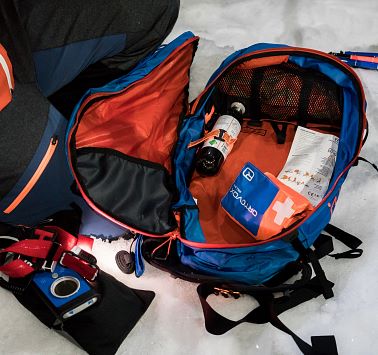Ortovox Avalanche Courses

As a outdoor sport, ski mountaineering is great for your health. Nevertheless, safety is paramount to your mountain experience. It is therefore important that you observe and comply with essential rules of conduct and instructions. Accurate tour planning and adequate equipment are also essential ingredients for a successful snowshoe tour.
Ski mountaineering is an endurance sport. You must make a realistic self-assessment and be in good health to be able to cope with the positive effects of exercise on the heart and circulation. Avoid time pressures and set the pace so that nobody in the group gets out of breath.
Hiking maps, guidebooks, the internet and local experts can provide information about the length, difference in altitude, difficulty and the prevailing conditions. Pay particular attention to the weather forecast, as cold, wind and poor visibility greatly increase the risk of accidents. Also plan alternative routes. Inform you about national mountain rescue emergency numbers (Euro emergency 112).
Potential hazards include: Sudden falls in temperature, snowfall, wind, avalanches, fog, ice, sun (diurnal heating – increased risk of avalanches). Various weather conditions change the terrain every day. You are personally responsible for assessing at your own discretion whether a route is safe!
Choose your equipment adequately to the winter conditions and the specific tour destination. Standard emergency equipment includes an avalanche transceiver, probe and shovel, as well as a first aid kit, bivouac sack and mobile phone. An airbag system increases the chances of survival. Check your equipment before setting off and carry a repair kit.
Before starting your tour, inform yourself in detail about the avalanche danger: How? Where? What? Pay particular to information on the danger level (1-5), danger spots (Where is it dangerous today?) and danger patterns (What is the main danger today?).
Current avalanche situation report Tyrol
Here you will find all the information on avalanche danger levels, snowpack structure, danger patterns, trends, alpine weather report and much more.
lawinen.reportWhen it comes to recognising the avalanche danger, humans have narrow limits. Base your decisions on strategic methods of risk assessment (reduction methods) and learn to recognise danger signs in the terrain. Avoid danger spots and turn back in case of doubt.
Fluids, energy and breaks are necessary to maintain performance and concentration. Hot, isotonic drinks are ideal thirst quenchers and warmers. Orientate yourself continuously ("I know where I am") and critically assess existing tracks.
Distances serve to relieve the snowpack and limit damage. Relief distances of 10 m when ascending steep slopes also increase comfort when making hairpin turns. When skiing downhill, always keep a distance of at least 30 m and ski very steep slopes individually.
Falls on the descent are the most frequent cause of accidents on ski tours. They mean a great deal of additional stress for the snow surface. Good skiing technique and a speed adapted to your ability reduce the risk. A ski helmet protects against head injuries. Caution: Danger of falling on frozen snow and in rocky terrain.
Small groups (up to 6 people) increase safety. Communication with other winter sports enthusiasts and mutual consideration prevent dangerous situations. Stay together in the group. Inform familiar people about destination, route and return. Attention mavericks: Even small incidents can lead to serious emergencies
The mountains offer a precious space to move in unique wilderness. Enjoy this freedom! Be considerate of wildlife, respect protected areas and do not enter reforested areas. To get there, carpool or use public transport.
Dogs
Please use dog waste bags and dispose of them in the nearest bin to avoid contaminating the pastures and natural environment. Help to keep the hiking trails clean. To avoid problems with cross-country skiers, snowshoe hikers and other winter sportspeople, always keep your dog(s) on a lead.
Rubbish
Nature is precious – so please keep the mountains clean and take your rubbish with you. Your rubbish will stay here, even when you’re long gone!
Saubere Berge
Tipps vom ÖAV
Damit Sie stets eine wunderschöne Landschaft bei Ihren Skitouren genießen können, ist es wichtig, dass jeder einzelne von uns auf die Umwelt achtet.
TippsWhat to do in case of an emergency?
Call the emergency service!
140 - Alpine emergency call (mountain rescue)
112 - European emergency call
133 - Police
144 - Ambulance
You are responsible for yourself on the slopes. Alpine dangers, especially avalanche danger, must be assessed by yourself. Emergency equipment must be carried. Ski slopes are primarily available to customers of the cable cars and lifts. In order to avoid accidents and conflicts, we ask you to observe the following recommendations in addition to the FIS rules of conduct.
Please note that the information provided regarding safety in the mountains is a recommendation only on behalf of the Tourismusverband Wilder Kaiser. All information is subject to change without notice.